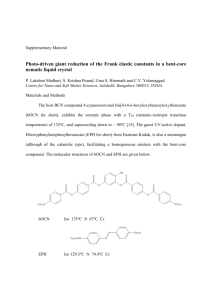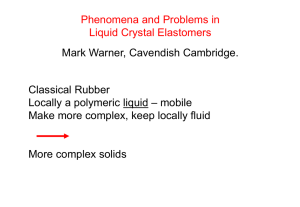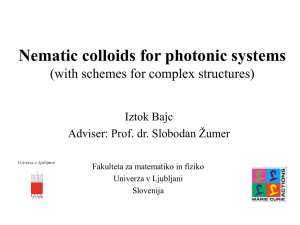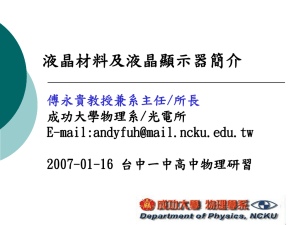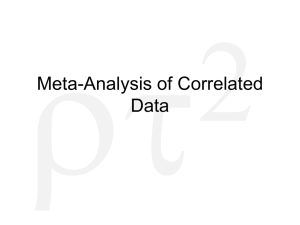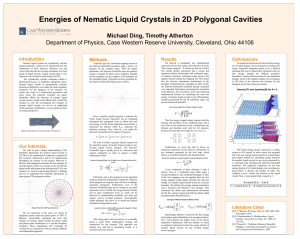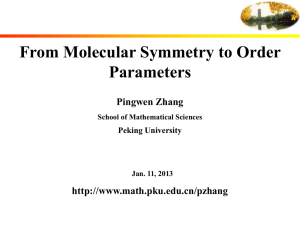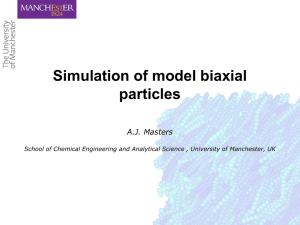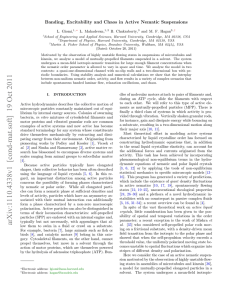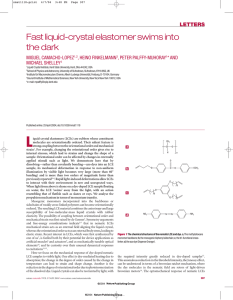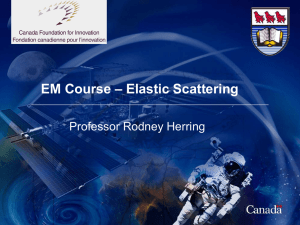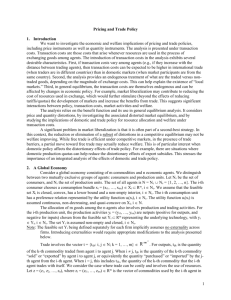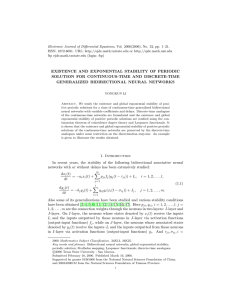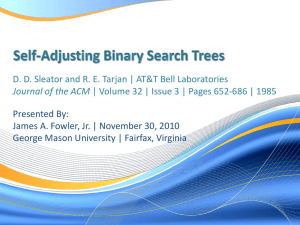prenta-predstavitev
advertisement
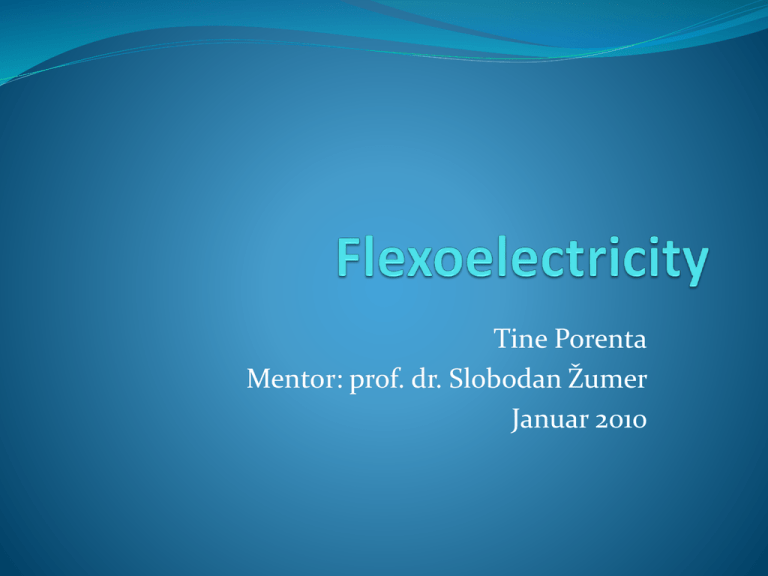
Tine Porenta Mentor: prof. dr. Slobodan Žumer Januar 2010 Seminar Introduction in liquid crystals Basics of flexoelectricity Theory Numerical method Radial nematic-filled sphere Radial nematic-filled sphere with point-like defect Radial nematic-filled sphere with hedgehog defect Conclusion Introduction in liquid crystals Materials with properties most useful for different applications in the modern world Liquid oily materials made of rigid organic molecules In proper temperature region they can self orginise and form a mesophases between the liquid and solid state Mesophases are characterized by orientational and positional order of the molecules Nematic phase is the least ordered phase influenced only by long-range order but no positional order. Long-range order is the phenomenon that makes liquid crystal unique They are typically highly responsive to external fields In confined geometries opposing orientational ordering of different surfaces can lead to formation of regions, where orientation is undefined -> defects. Defects can be either point-like or lines. The average of the molecules are described as a director n. Director is aporal, meaning the orientation n an –n are equivalent. Degree of order: Orientational fluctuations of the molecules are defined as an ensemble average of the second Legendre polynomials S = <P2(cos )> The director and the nematic degree of order can be joint together in a single tensorial order parameter defined as S Qij (3ni n j ij ) 2 By definition Qij is symmetric and traceless. Its largest eigenvalue is nematic degree of order S and the corresponding eigenvector is the director n Phenomenological Landau – de Gennes (LdG) total free energy is used to incorporate liquid crystal elasticity and possible formation of defects: 1 Qij Qij dV F L 2 xk xk LC 1 1 1 2 AQijQ ji BQijQ jk Qki C QijQ ji dV 2 3 4 LC Elastic deformation modes: (a) splay, (b) twist and (c) bend Electric field couples with nematic through a dielectric interaction with induced dipoles of the nematic molecules. Within the LdG framework, the electric coupling is introduced as an additional free energy density contribution 1 Fd 0 ij Ei E j dV 2 LC where ij is defined as 1 2 ij 2 || ij || Qij 3 3S || and are dielectric constant measured parallel and perpendicular to the nematic director From piezoelectricity to flexoelectricity Piezoelectricity is the ability of some materials to generate an electric field or electric potential in response to applied mechanical stress. The effect is closely related to a change of polarization density within the material's volume. The internal stress in this materials is proportional to electric field inside. Stress tensor is defined as F ij u ij T , E 1 ui u j uij 2 x j xi T , E Electric displacement field is then Di Di ij E j i, jk ij 0 where i,jk tensor rank three with symmetry i,jk = i,kj . If tensor is known, piezoelectric properties are entirely determined In liquid crystals exist phenomenon similar to piezoelectricity that occurs from the deformation of director filed Di ij Ei e1n( n) e3 (( n) n) wiht coefficients e1, e3 10-11 As/m Polarisation induced by splay and bent deformation The total macroscopic polarisation induced by deformation of liquid crystal is introduced by using a nematic degree of order Qij Pi Gijkl xl where Gijkl is a general fourth rank coupling tensor, which incorporates flexoelectric coefficients e1 and e3 For simplicity -> one constant approximation Gijkl=G The corresponding free energy: Qij E j dV F G xi LC Numerical method Numeric relaxation method was developed to calculate the effect of flexoelectricity Electric potential and the profile of the nematic order parameter tensor are alternatively computed, until converged to the stable or metastable solutions Cubic mesh with resolution of 10 nm Strong anchoring on boundaries is assumed The total free energy is Electric potential is miminized by using EulerLagrange algorithm calculated from Maxwell’s equations in an anisotropic medium 1 Qij Qij dV F L 2 xk xk LC 1 1 1 2 AQ Q BQ Q Q C Q Q dV ij ji ij jk ki ij ji LC 2 3 4 1 dV 0 ij 2 LC xi x j Qij dV G xi x j LC 2 Qij 0 ij G 0 xi x j xi x j 1 2 ij 2 || ij || Qij 3 3S Scheme: Nematic and dielectric constants A, B, C, L, || and are taken. Radial nematic-filled sphere Effect of the flexoelectricity are typically small in the absence of the external fields (Fflex < 1% Ftotal), but in some geometries like nematic filled sphere can become substantial importance. Radial nematic-filled sphere with point-like defect existance of analytical solution of flexoelectric quantities for isotropic medium only splay deformation of a director field director field can be represented in spherical coordinate system as n=(1,0,0) Pflex e1n ( n ) 1 r 2 e1 (1,0,0) 2 r r 2e1 ,0,0 r ( 0 E ) Pflex 0 E Pflex C 2e1 E ,0,0 r 0 Flexoelectric contribution to the total free energy Fflex Pflex EdV V 16e12 R 0 Radial nematic-filled sphere with hedgehog defect Electric potential induced by flexoelectricity affects the nematic profile, primarily in the core region of the defects. (a)Electric field induced by flexoelectricity and spatial distribution of elastic (b), dielectric (c) and flexoelectric (d) contribution to the total free energy Conclusion Coupled numerical method was developed for the study of flexoelectricity in nematic liquid crystals to show us that flexoelectricity induces substantial electric potential in the regions surrounding the defects Flexoelectricity affects defect cores and changes their size Flexoelectricity could change stability of defect configurations in confined geometries Flexoelectric contribution to the total free energy has quadratic dependence on flexoelectric coefficient and could become important factor for materials with high flexoelectric coefficients
